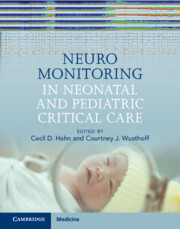Book contents
- Neuromonitoring in Neonatal and Pediatric Critical Care
- Reviews
- Neuromonitoring in Neonatal and Pediatric Critical Care
- Copyright page
- Contents
- Contributors
- Acknowledgements
- Part I General Considerations in Neuromonitoring
- Chapter 1 Overview of Continuous EEG Monitoring in Critically Ill Neonates and Children
- Chapter 2 Technical Aspects of Neurophysiological Monitoring
- Chapter 3 Logistics of Neuromonitoring
- Chapter 4 Nursing Considerations in Neuromonitoring
- Chapter 5 Normal Neurophysiology, Benign Findings, and Artifacts
- Chapter 6 Abnormal EEG in the Intensive Care Unit
- Part II Practice of Neuromonitoring: Neonatal Intensive Care Unit
- Part III Practice of Neuromonitoring: Pediatric Intensive Care Unit
- Part IV Practice of Neuromonitoring: Cardiac Intensive Care Unit
- Part V Cases
- Index
- References
Chapter 1 - Overview of Continuous EEG Monitoring in Critically Ill Neonates and Children
from Part I - General Considerations in Neuromonitoring
Published online by Cambridge University Press: 08 September 2022
- Neuromonitoring in Neonatal and Pediatric Critical Care
- Reviews
- Neuromonitoring in Neonatal and Pediatric Critical Care
- Copyright page
- Contents
- Contributors
- Acknowledgements
- Part I General Considerations in Neuromonitoring
- Chapter 1 Overview of Continuous EEG Monitoring in Critically Ill Neonates and Children
- Chapter 2 Technical Aspects of Neurophysiological Monitoring
- Chapter 3 Logistics of Neuromonitoring
- Chapter 4 Nursing Considerations in Neuromonitoring
- Chapter 5 Normal Neurophysiology, Benign Findings, and Artifacts
- Chapter 6 Abnormal EEG in the Intensive Care Unit
- Part II Practice of Neuromonitoring: Neonatal Intensive Care Unit
- Part III Practice of Neuromonitoring: Pediatric Intensive Care Unit
- Part IV Practice of Neuromonitoring: Cardiac Intensive Care Unit
- Part V Cases
- Index
- References
Summary
Continuous EEG (cEEG) monitoring offers bedside, noninvasive, diffuse, and continuous information about brain function. These characteristics allow clinicians to assess brain function, evaluate for changes in brain function over time, and identify electrographic seizures that are often not clinically observable. These advantages have led to widespread and increasing use of cEEG in critically ill patients across the age spectrum. This chapter introduces cEEG in critically ill neonates and children including seizure epidemiology (incidence and risk factors), the relationship between electrographic seizures and outcome, available consensus statements and guidelines, and role of quantitative EEG.
- Type
- Chapter
- Information
- Publisher: Cambridge University PressPrint publication year: 2022



